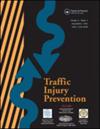Drunk driving has a speeding problem
IF 1.9
3区 工程技术
Q3 PUBLIC, ENVIRONMENTAL & OCCUPATIONAL HEALTH
引用次数: 0
Abstract
Objectives
Alcohol and excessive speeding are both linked to elevated crash risk. Alcohol-related and speeding-related crashes are recorded and treated as distinct, with separate etiologies. Yet, speeding and alcohol use are interrelated. We speculate that speeding might account for some of the crash risk associated with drunk driving.
Methods
Data from the Crash Investigation Sampling System were analyzed. Vehicle speeds, measured moments before crashes, were estimated from driver blood alcohol concentrations (BACs) for different levels of injury severity. We first applied a previously published formula to estimate the relative crash risk associated with speeds that occur at different BACs. Then, from the literature we obtained relative crash risk odds ratios associated with different BACs. Finally, for BACs of 0.08 g/dl and 0.16 g/dl, separately for serious injury and fatality crashes, we created ratios to estimate what portion of the alcohol-crash risk might be attributed to higher travel speeds.
Results
A statistically significant BAC × Injury Severity interaction indicated that crash drivers with higher BACs drove faster than their sober counterparts, and that this was exacerbated for more serious injuries. Among drivers with fatal injuries, those with BACs of 0.16 g/dl were traveling over 10 mph faster than their sober counterparts. Finally, using this information, for drivers at different BACs, we compared the crash risk attributable to speed with the crash risk as a function of alcohol levels. Accordingly, we estimate that at 0.08 g/dl, higher speeds accounted for nearly 50% of the fatality crash risk attributed to alcohol, and 25% of the fatality crash risk at 0.16 g/dl. For serious injuries, estimates were 39% and 16%, respectively.
Conclusions
The literature on alcohol-related crashes widely attributes the increased crash risk to impaired driving skills, such as attention, coordination and reaction time. Our analysis suggests that speeding alone might account for some of this elevated risk. This has implications for understanding the etiology of alcohol-related crashes. We also suggest that speed control may be a viable means of reducing the harm from alcohol-related crashes.
酒驾有超速的问题。
目的:酒精和超速驾驶都与撞车风险增加有关。与酒精有关的和与超速有关的撞车事故被记录下来,并作为不同的原因进行处理。然而,超速和饮酒是相互关联的。我们推测超速驾驶可能会导致一些与酒后驾车相关的撞车风险。方法:对事故调查抽样系统的数据进行分析。在碰撞发生前的瞬间测量的车速,是根据驾驶员血液中的酒精浓度(BACs)来估计不同程度的损伤严重程度。我们首先应用了先前发表的公式来估计不同bac发生的速度相关的相对碰撞风险。然后,从文献中,我们获得了与不同bac相关的相对崩溃风险比值比。最后,对于分别为0.08 g/dl和0.16 g/dl的严重伤害和致命碰撞的bac,我们创建了比率来估计更高的行驶速度可能导致的酒精碰撞风险的比例。结果:具有统计学意义的BAC与损伤严重程度的相互作用表明,BAC较高的撞车司机比清醒的司机开车更快,并且这种情况在更严重的伤害中加剧。在有致命伤害的司机中,BACs含量为0.16 g/dl的司机比清醒的司机行驶速度快10英里/小时。最后,利用这些信息,对于不同bac的驾驶员,我们比较了由于速度导致的碰撞风险和由于酒精水平导致的碰撞风险。因此,我们估计,在0.08 g/dl时,更高的速度占酒精导致的死亡事故风险的近50%,在0.16 g/dl时占死亡事故风险的25%。对于严重伤害,估计分别为39%和16%。结论:关于酒精相关车祸的文献普遍将车祸风险的增加归因于驾驶技能的受损,如注意力、协调性和反应时间。我们的分析表明,超速本身可能是导致这种风险升高的部分原因。这对理解与酒精有关的撞车事故的病因有一定的意义。我们还建议,速度控制可能是减少与酒精有关的撞车伤害的一种可行方法。
本文章由计算机程序翻译,如有差异,请以英文原文为准。
求助全文
约1分钟内获得全文
求助全文
来源期刊

Traffic Injury Prevention
PUBLIC, ENVIRONMENTAL & OCCUPATIONAL HEALTH-
CiteScore
3.60
自引率
10.00%
发文量
137
审稿时长
3 months
期刊介绍:
The purpose of Traffic Injury Prevention is to bridge the disciplines of medicine, engineering, public health and traffic safety in order to foster the science of traffic injury prevention. The archival journal focuses on research, interventions and evaluations within the areas of traffic safety, crash causation, injury prevention and treatment.
General topics within the journal''s scope are driver behavior, road infrastructure, emerging crash avoidance technologies, crash and injury epidemiology, alcohol and drugs, impact injury biomechanics, vehicle crashworthiness, occupant restraints, pedestrian safety, evaluation of interventions, economic consequences and emergency and clinical care with specific application to traffic injury prevention. The journal includes full length papers, review articles, case studies, brief technical notes and commentaries.
 求助内容:
求助内容: 应助结果提醒方式:
应助结果提醒方式:


